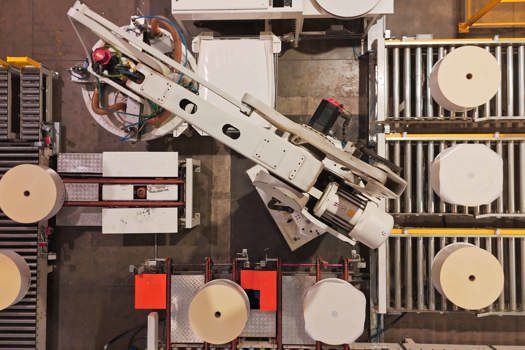Inside, a team of 80 works to conserve ancient manuscripts and first editions of some of the country’s earliest printed texts. Antique books, scrolls and maps enter the building, which is sited behind the main British Library, through a secure underground tunnel that connects the five floors of storage beneath the library to the conservation centre. New arrivals are taken into the quarantine room to check for infestations of mould or insects, as one contaminated book could bring in insects that would attack the rest of the collection. Items found to be carrying insects are placed into a freezer, while mould can be killed using a low-oxygen chamber.
The documents are then taken up to the specially designed workshops to be treated. “It’s not about restoration, it’s preservation,” explains head of conservation Vicki Humphrey. “You can’t take these books back in time and make them look as they did when they were created. Our job is to stop them decaying any further and make them usable now.”
Natural materials
Common problems are rips and tears, brittle paper, red rot, damage to the leather bindings and broken stitching. Rips, as well as spoiling the appearance of a piece, are likely to spread, damaging more of the item. And when the book is 500 years old and the only surviving edition, Sellotape isn’t an option.
The conservators use a fine handmade mulberry-fibre paper called Kozo, shipped over from Japan, for repairs. A paste made from wheat starch is used to glue in the Kozo paper. Natural materials are used to avoid introducing new chemicals and the techniques must be as sympathetic to the original creation as possible. Centuries-old book binding methods are used, employing wooden sewing frames, to restore damaged casings. Enormous wooden guillotines sit in the brand-new space alongside modern computers and light boxes.
“The past 100 years have been a period of rapid change in terms of book production,” says Humphrey.
So, as newer works come in, the methods used for storing and protecting them have to change. “Paper has become more mass-produced and often uses optical brighteners, which disguise the condition of the paper. Inkjet ink is water soluble, which means it dissolves if we use wheat starch paste for repairs,” she adds.
Then there are more unusual demands. As a copyright library, the British Library receives a copy of every book published in the UK, including scratch ‘n’ sniff books. “It has been difficult to know how to store them to preserve the smell, yet stop them affecting the other books,” says Humphrey.
“When the building was being planned, the often-conflicting needs of the books and the conservators had to be considered,” explains Guy Channer, team project director of Arup, the global design and business consulting firm that designed the new conservation centre.
Conservators need plenty of light to be able to see the delicate work they are doing, but bright light and, in particular, the UV in sunlight can result in pigment loss. As a result, the conservation centre has been designed with a ‘sawtooth roof’, with large north-facing skylights. These, combined with floor-to-ceiling windows along the north side of the building, ensure maximum natural light without damaging UV light getting in. The architects ran tests to ensure that the workshops were safe from sunlight at all times of the day and year.
Temperature control
Channer continues: “The ideal temperature for book conservation is around 16C, but this would be a little nippy for people to be working in.” Fluctuations in temperature and humidity cause more damage, especially to delicate materials such as vellum (an untanned animal skin that many ancient texts are written on), than the heat itself. As a result, the books cannot be kept in cold storage because of the damage that would be caused when they were brought out for use or conservation work.
Consequently, the temperature and humidity of both the storage areas and workshops have to be carefully controlled. Due to the need for natural light, air-conditioning vents could not be placed on the ceiling. Instead, vast grills form the end of each workbench, to ensure a constant and very slow-moving flow of air. When working on fragile book leaves or using tiny scraps of paper, a sudden gust of air could be catastrophic. An ancient Japanese tool called a kari bari board, made from layers of paper treated with fermented persimmon juice, is used for drying pages that have been washed.
Once the books have been stabilised they can be taken to the finishing room, where final touches such as gold leaf are added. A substance called glare, made from fermented egg whites, is used to glue the gold leaf in place, which is then imprinted using handheld heated metal tools.
Protective storage
Before books go back into storage, a Zünd precision cutting tool is used to create an acid-free cardboard box for each book. “It’s partly to protect the books when they are being stored and partly because readers will handle a book with more care if you give it to them in a box,” Humphrey explains.
Completed in 1997, the British Library is the largest public building constructed in the UK in the 20th century. Very little of the library’s collection is kept on open shelves in the nine floors above ground, the majority of the on-site collection is stored in the basements. And while this protects materials from sunlight, it means that a flood could destroy enormous swathes of priceless documents. As a result, the library site has been designed so that the ground and surrounding roads rise up to form a bund, or protective ridge, around the library, which means that two large watermains can burst and the water will flow around the outside of the bund and not over it and into the basements.
Last month, the conservation centre opened a small exhibition explaining the work of the conservators. It is also running a series of events and, from October, behind the scenes tours to see the conservators at work. Internships in conservation will be offered from October. For more information visit: www.bl.uk
CASE STUDY: MERCATOR'S ATLAS
Mercator’s Atlas, compiled by Flemish cartographer Gerardus Mercator in the early 1570s, contains the only extant parts of his influential 1554 wall map of Europe.
The atlas, which was made by cutting and pasting copies of his previously published wall maps, only came to light in 1967 and was acquired by the British Library in 1997.
Prior to treatment, almost all of the pages were torn at the edges. The verdigris pigment in the hand colouring had caused the paper to fracture. Investigations revealed risks in exposing the verdigris to the usually recommended treatments, as it produces copper oxalates, which are highly reactive to light, heat, alkali and moisture.
Examination revealed a gypsum layer under the pigment, which is very significant for understanding map manufacture in the 16th century. Any aqueous treatment would have resulted in the loss of this information.
In its pre-treatment condition, the binding was not offering the textblock any support. The boards were soft and worn, the sewing had broken and the backs of the textblock sections were exposed.
The boards were consolidated and strengthened, and the edges were built up to ensure the textblock was fully protected. The book was carefully resewn using the original supports and re-covered with a quarter binding.







